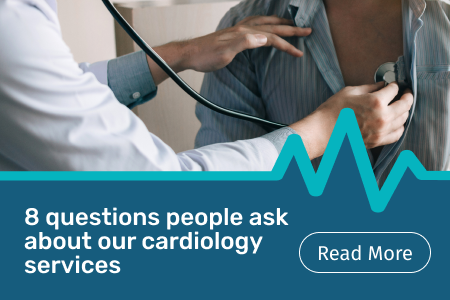
Cardiology Service
We perform the most advanced cardiac procedures thanks to Melbourne Heart Care treating their patients here. Yet it’s not just the number and complexity of surgeries that make us the heart of cardiac health care - the equipment and technology are state of the art.
We provide comprehensive and integrated cardiology care incorporating diagnostic, therapeutic and procedural services in our leading edge catheter lab theatre. All our cardiac services are supported by our 9 bed coronary care unit and 6 bed intensive care unit.
The private experience
Expect better when you’re with us. Most patients enjoy a single or double room. We provide our patients with additional services including:
- Access to dietitian services
- Pre-admission clinic services
- Specialised physiotherapy services
You truly are our focus.
Next steps
If your GP has recommended more complex cardiac care, ask for a referral to one of the state’s leading specialists. Tell them that you prefer to be treated at Holmesglen Private Hospital, the heart of cardiac care.
Our world class cardiologists and cardiothoracic surgeons treat a range of heart conditions and related symptoms.
If you are experiencing any of the symptoms listed below:
- Chest pain/Angina
- Palpitations- racing or irregular heartbeat.
- Shortness of Breath
- Dizziness or fainting
- Signs of heart failure – swollen ankles, unable to lie flat or waking short of breath
You should contact your GP or present to our emergency department for assessment. If you require urgent attention dial 000 (triple zero) and ask for an Ambulance.
Heart disease remains the main cause of death in Australia. Holmesglen Private Hospital is one of Melbourne’s leading cardiac hospitals, where the state’s most sought after cardiac providers fight this statistic by dedicating themselves to the best possible care.
It's safe to say that you, the patient, are at the heart of everything we do.
Procedures we offer:
Coronary angiography is the process of taking images of thecoronary “heart” arteries by passing a thin tube called a catheter through anarm and leg artery to the top of the heart. A small amount of contrast isinjected and an x-ray camera outside the body takes images.
Coronary angioplasty and stenting are procedures to reopenblocked or significantly narrowed coronary arteries. This may involve inflatinga balloon or placing a stent (an expandable metal scaffold) into the artery torestore blood flow.
Angiography and stenting are commonly performed under localanaesthetic and IV sedation without the need for a general anaesthetic.
CTCA usescomputed tomography (CT) scanning to take detailed images of the heart. It is aquick (scanning takes 15 seconds) and easy test, without the need for invasiveprocedures, to determine if there are any significant narrowing in the heartarteries.
DCcardioversion (DCCV) is used to treat irregular heart rhythms - commonly atrialfibrillation. The procedure involves a general anaesthetic and placement ofelectrodes on the chest. An electrical impulse or shock is delivered to returnthe heart rhythm to normal.
Electrophysiology(EP) studies, are a series of tests that examine your heart's electricalactivity. They involve mapping the electrical paths in the heart to determineif significant electrical abnormalities exist. This may be carried out prior toconsidering the best management for heart arrhythmias.
Cardiacablation uses heat (radiofrequency) energy to create tiny scars in your heartto block abnormal electrical signals that cause rhythm disturbances. Thisprocedure is used to correct heart rhythm problems such as atrial fibrillation.
An implantableloop recorder is a convenient and easy way to obtain long term ECG recording byimplanting a tiny paperclip sized device under the skin. This device can recordECGs for 3 plus years and is generally suited for patients with unexplainedfainting and strokes/ministrokes of unknown cause. Your doctor can remotelymonitor your heart rhythm via a mobile link that you keep in your home.
A pacemaker isa small device usually inserted under the skin of the upper chest and attachedto a pacing wire that paces your heart when your heart is unable to do soadequately. This procedure is commonly performed under local anaestheticwithout the need for a general anaesthetic.
Atransesophageal echocardiogram is a type of echocardiogram (heart ultrasound)that takes images from behind the heart. This is achieved by passing the probedown the back of the throat (very similar to an endoscopy or gastroscopyprocedure). The images obtained are of better quality than a normalechocardiogram due to the lack of lung (air) between echo probe and heart.



